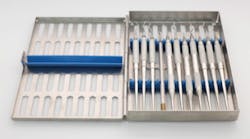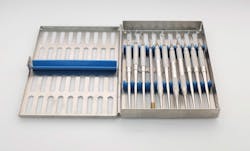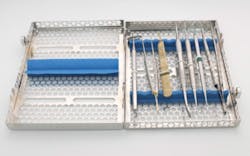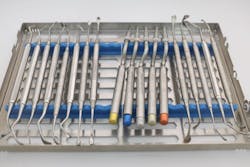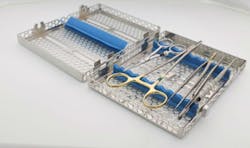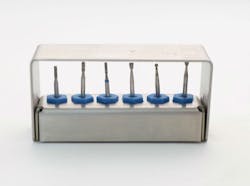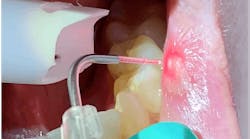Effective cross-infection control with instrument sterilization cassettes and how to use them with typical dental instrument kits and procedures
Dentalytec summarizes instrument cleaning and sterilization methods recommended to prevent cross infection and explains how instrument sterilization cassettes offer a time- and cost-effective way to sterilize dental instruments. Cassettes offer an organized storage space for instruments before, during, and after sterilization, and can be used as typical—or customized—instrument kits based on the dental procedure being performed.
ONE OF THE MOST IMPORTANT ASPECTS OF PROFESSIONAL DENTAL PRACTICE IS ADHERING TO STRICT CROSS INFECTION CONTROL PROCEDURES. A widely used solution to prevent cross infection is the use of disposable instruments. However, despite the initial attractiveness of the idea, disposable instruments are not as practical or cost-effective in the long run compared to properly maintained nondisposable dental instruments. And it is still worth the time and effort to establish effective cleaning and instrument sterilization procedures and follow proper infection control guidelines, such as those recommended by the Centers for Disease Control and Prevention (CDC).
There is a more time- and cost-effective way to accomplish the task of dental instrument sterilization—instrument sterilization cassettes—that can offer such benefits. In this article, we will focus on some of the cleaning and sterilization procedures required for cross infection control, as well as look at the types of dental sterilization cassettes that can be used for typical instrument kits according to the dental procedure being performed.
Cleaning dental instruments
Dental instrument sterilization is performed to kill the bacteria and other harmful organisms that are attached to the instruments. Complete and thorough sterilization requires that all surfaces of the instruments be completely clean and free of debris. Listed below are some of the methods that can be used to clean dental instruments prior to sterilization.
Manual cleaning: Scrubbing dental instruments with hands is the most primitive method of instrument cleaning. However, this method is quite dangerous, since there are chances of injury and cross infection during the cleaning process. This type of cleaning procedure is reserved only for instruments such as dental handpieces that are hard to clean using other methods.
Ultrasonic cleaning: The biggest advantage of ultrasonic cleaning machines is the reduced contact with contaminated instruments and, therefore, less chance of cross infection. An ultrasonic machine generates heavy turbulence inside the ultrasonic cleaning liquid, which creates billions of continuously imploding bubbles. The vibration generated from these bubbles results in effective removal of all debris from the instruments. Another advantage of ultrasonic cleaning machines is that they can clean both loose instruments as well as those secured in instrument sterilization cassettes.
Instrument washers: Instrument washers can also be used to clean dental instruments. After the instruments have been placed inside the washer, they are exposed first to a spray mixture of water-detergent solution. Next, they are thoroughly cleaned by a pressurized stream of cleaning liquid. One advantage of using instrument washers is their capacity to clean a lot of instruments at one time.
Sterilization techniques for dental instruments
These are the different types of sterilization processes that can be used for dental instruments.
Autoclaving using pressurized steam: This method uses an autoclave chamber filled with pressurized steam for a certain period of time. Complete sterilization of the instruments is only possible when the air inside the autoclave is completely evacuated, which can be done by one of two methods: (1) The steam displaces the air already present inside the chamber (gravity displacement), or (2) the air is evacuated through a vacuum and then the steam is introduced. After the sterilization cycle is completed, the packages containing the sterilized instruments are allowed to dry completely before they are taken out of the autoclave. The instruments are now ready for use.
Dry heat ovens: These are electrical devices that use dry heat to sterilize the dental instruments. Since they do not require water for sterilization, very little pressure develops inside them. Consequently, dry heat ovens are safer than steam autoclaves. Since heat generation is electrically controlled, optimal sterilization temperatures can be attained rapidly. A disadvantage of dry heat ovens is that they may not be able to completely kill all microbes, such as prions. Dry heat ovens are used to sterilize the instruments that do not get burned during heating, such as glass slabs or powders.
Chemical vapor sterilization: During chemical vapor sterilization, a mixture of various chemicals—such as alcohol, ketones, formaldehyde, and water—is heated under pressure to form a sterilization gas. A typical sterilization procedure requires 20 minutes to complete at 270ᵒ F under a pressure of 20 psi.
Cold sterilization: Cold sterilization is a sterilization process used for heat-sensitive dental instruments. Solutions such as glutaraldehyde or sodium hypochlorite may be used for this purpose. This procedure requires quite a bit of time to complete the entire sterilization process, so it is not recommended for dental instruments. The chemicals in this process, however, can be used for high-level disinfection purposes.
Caring for instruments during cleaning and sterilization
Regardless of the sterilization method used, one of the downsides of working with multiple instruments in various dental procedures is keeping them organized in such a way that makes them easier and faster to find when needed. This is especially true in busy clinics where the sterilization room is always in use. Another common problem encountered while working with dental instruments is sharps injury. Most instruments have very sharp working ends, which can accidentally cause injury or more serious harm to dental professionals if the instruments were contaminated prior to cleaning or sterilization.
In light of this, more clinics are using dental instrument cassettes because they not only address cross infection prevention and the other issues mentioned above, but the cassettes are less expensive and more time-efficient. The initial small capital invested in purchasing instrument cassettes is regained after only a few short months, depending on frequency of use. The cost savings, as a direct effect of labor time saved in the sterilization room and indirectly from prolonged life of the instruments, begins building up thereafter.
Enter dental sterilization cassettes
Sterilization cassettes are simply metallic boxes that contain customized slots for the placement of various dental instruments. These slots are prepared while keeping in view the size, length, thickness, and type of working ends of different dental instruments. Sterilization cassettes were initially used by hospitals for sterilizing surgical instruments used in medical procedures. In recent years, there has been a significant increase in the use of cassettes for cross infection prevention in dental practices as well.
Perhaps the biggest advantage of using sterilization cassettes is the excellent organization and storage space they provide for instruments before, during, and after sterilization. In fact, after the instruments have been sterilized, those same instruments that are required for a specific procedure can be kept inside the same cassette and used when that procedure is performed again. In this way, dentists and dental assistants will not have to look for instruments while surgery is being performed, thereby significantly improving efficiency and productivity.
Dentalytec offers various types of instrument sterilization cassettes that can be customized for different types of dental procedures, such as restorative, surgical, and periodontal. Listed below are six examples of instrument cassette models that can be used to organize instruments for specific dental procedures.
No. 1: Instrument kit for scaling and root planing procedures
Dentalytec Slim M Cassette
For sterilization, packaging, and organization of instruments used for scaling and root planing procedures, Dentalytec recommends using the Slim M Cassette model. Not only is this cassette specifically designed for such procedures, but it is also very compact and takes up less space, making it very practical for storage after sterilization.
These are the typical instruments used in scaling and root planing that can be used with this model:
- Sickle
- Jacquette
- Hoes
- Mirror
- Probe
- Scaler tips
The Slim M Cassette can be used to sterilize up to 10 instruments at a time.
No. 2: Instrument kit for minor surgical procedures
Dentalytec Vision+ M Cassette
With the Vision+ M Cassette, you can prepare your own customized minor oral surgical instrument kit, which can consist of the following:
- Blade holder
- Periodontal elevator
- Surgical forceps
- Needle holder
- Retractor
- Dental mirror
- Periodontal probe
The Vision+ M Cassette has been specifically designed to protect the working ends of surgical instruments. You can sterilize up to 10 instruments using the Vision+ M Cassette.
No. 3: Instrument kit for main surgical procedures
Dentalytec Classic L Cassette
The Classic L Cassette is typically for instruments used in implantology and other main surgical procedures. The Classic L is the largest model offered by Dentalytec—it can hold up to two large surgical instruments. This sterilization cassette has an open-lid design, which helps in arranging surgical instruments for a procedure. The following instruments can be used with the Classic L Cassette:
- Blade holder
- Periodontal elevator
- Forceps
- Extraction forceps
- Needle holder
- Retractors
- Dental mirror
- Periodontal probe
No. 4: Instrument kit for restorative dental procedures
Dentalytec Clip M Cassette
The Clip M Cassette contains a clip, which allows convenient opening or closing of the cassette lid, as well as securing the instruments during cleaning and sterilization procedures. This cassette has been designed for the placement of instruments that are not sharp and that do not need to be placed in a closed cassette system. The Clip M Cassette can be used to sterilize the following instruments used in restorative dentistry:
- Pluggers
- Plastic instrument
- Burnisher
- Excavator
- Tweezers
- Carvers
- Mirrors
- Periodontal probe
No. 5: Instrument kit for suturing
Dentalytec Vision+ M Cassette
The Vision+ M Cassette is also ideal to use for suturing instrument kits. Slots within this cassette are designed specifically to accommodate sharp surgical instruments securely. The Vision+ M Cassette can be used to sterilize up to 10 instruments at a time. Some of the instruments that can be used with this cassette are:
- Tweezers
- Needle holders
- Scissors
No. 6: Instrument kit for root canal treatment procedures
Dentalytec Plugin 6H40
- Plugin 6H40: Mostly small and sharp instruments are used during root canal procedures. Dentalytec recommends the use of Plugin 6H40 for sterilization and organization of endodontic files and burs. The Plugin 6H40 can be used for sterilization of all types and sizes of endodontic files.
- Plugin 6H30: This plugin system can ideally be used for sterilization of up to six burs of the 4, 8, 12, 16, and 30 heights. The Plugin 6H30 can perfectly fit burs used during endodontic procedures.
- Plugin 6H60: Like the other plugin systems offered by Dentalytec, this plugin can be used for sterilization of different types of burs that are used in surgical procedures. This plugin is 60 mm high, which can accommodate longer surgical burs.
The recommendations in this article serve only as a general idea of how dental instruments can be paired with these instrument kits for use during common dental procedures. However, these are by no means the only instrument kit configurations or arrays of instruments that can be used together with the instrument sterilization cassettes. Both the cassettes and plugins can be used with other kinds of instrument kits and setups that are required for specific dental procedures or various practitioners' preferences.
Article supported by Dentalytec
